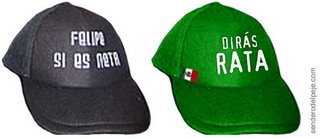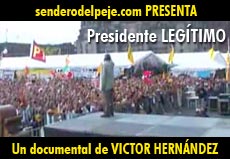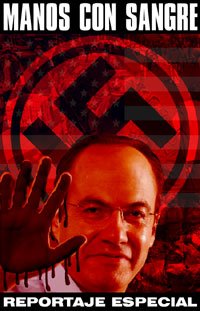Iba a poner una broma pesada de dia de los inocentes, pero francamente ante las noticias de hoy yo creo que ya ni falta hace. Porque a los que los hicieron inocentes fue a los que se tragaron el choro de que el PELELE sería el "presidente del empleo."
Me explico: uno de los spots de campaña del CEROTE CON PATAS llamaba a los jóvenes a que "se la jugaran" por fecal. Pero la referencia masturbatoria resultó ser una más de las tantas mentiras del CEROTE CON PATAS. Vean, por ejemplo, como en el primer año del espuriato creció el desempleo entre los jóvenes según esta nota del Universal:
Crece el desempleo entre los jóvenes mexicanos
Urgen especialistas a aprovechar “bono demográfico” del país; 1 millón 238 mil 661 jóvenes estuvieron desocupados, aunque buscaron un empleo, lo que implica un aumento de 82 mil 440 desempleados respecto al mismo lapso de 2006
Ixel Yutzil González
El Universal
Viernes 28 de diciembre de 2007
ixel.gonzalez@eluniversal.com.mx
En México, siete de cada 10 desempleados son jóvenes de entre 14 y 34 años de edad, y en los últimos dos años la desocupación entre este segmento de la población reportó el mayor avance.
Cifras del Instituto Nacional de Estadística, Geografía e Informática (INEGI) muestran que al tercer trimestre de 2007, un millón 238 mil 661 jóvenes estuvieron desocupados, aunque buscaron un empleo, lo que implica un aumento de 82 mil 440 desempleados respecto al mismo lapso de 2006.
En particular, la tasa de desempleo más alta por grupo de edad a septiembre de 2007 fue la de los jóvenes de entre 14 y 19 años, que representó 8.09% de la Población Económicamente Activa (PEA), de acuerdo con cifras de la Encuesta Nacional de Empleo realizada por el INEGI.
Dicha tasa es superior al promedio nacional, que es de 3.46% de la PEA.
De esta manera, el nivel de desempleo en los jóvenes en este rango de edad es la segunda más alta del país, ya que representa 20% del total de desocupados en México.
El organismo revela que el mayor problema no es que estén desocupados, sino que una tercera parte de los que hoy se ocupan, lo hacen en el sector informal de la economía.
A este respecto, explica que 10.5% del total de los ocupados en el sector informal de la economía tienen entre 14 y 19 años; en tanto 21.5% tiene de 20 a 29 años de edad.
Según un estudio realizado por la Asociación por la no discriminación laboral por la edad o género, en el lapso de un año 55% de los tipos de empleo son de ventas; 28% de personal de seguridad y limpieza; y 17%, categorizados en “otros empleos”.
En cuanto al género, 85% de las ofertas de empleo hace distinción por género, mientras que 15% no hace esta diferenciación.
Alienta empleo fin de año
Pese a ese escenario, de acuerdo al INEGI, en noviembre la tasa de desocupación fue de 3.46%, lo que significó una baja de 0.47% puntos porcentuales respecto al mes previo.
Expone que esto se atribuye al aumento en las contrataciones del sector servicios, principalmente, como consecuencia del inicio de temporada de ventas de finales de año.
Urgen aprovechar bono poblacional
Sin embargo, de acuerdo a especialistas de capital humano, el “bono demográfico”, que hoy representan estos jóvenes en edad de trabajar, está siendo desaprovechado, por lo que sugieren políticas públicas en materia laboral que impulsen la capacitación y la incursión de estas personas en los centros de trabajo.
Destacan que México esta en su mejor momento para desarrollarse, ya que a diferencia de otras naciones como las europeas, cuyas tasas de natalidad son bajas, en el país se goza de una amplia base de jóvenes decididos a conseguir un empleo remunerado.
Enrique Marín, director de la Práctica del Retiro de Mercer, explica que se cuenta con una década, aproximadamente, para formar a la juventud actual, con el propósito de ésta pueda insertarse sin problemas a las actividades productivas que permitirán el repunte económico de México, ya que entre más tiempo pase enfrentaremos un fenómeno de envejecimiento.
“Tenemos pocos años para aprovechar el bono demográfico y ver por la economía, porque después seremos un país de viejos”, asevera Enrique Marín.
De acuerdo a las encuestas más estadísticas más recientes de Mercer, hoy en día una de cada 13 personas tiene más de 60 años, pero a partir de 2050 la proporción será de uno por cada 3.5 personas.
No es que esta población esté siendo desaprovechada. Lo que pasa es que, para empezar, NO HAY EMPLEOS. En segundo lugar, a un patrón le conviene más tener empleados que tengan que mantener una familia por que son más fáciles de controlar. Los trabajadores jóvenes no tienen las mismas responsabilidades que un padre de familia y, por lo tanto, son más respondones y más proclives a no dejarse explotar.
Ah, y que conste: fecal hizo la enorme CHINGADERA de pagar con dinero del erario los impuestos que tienen que pagar los empresarios para el programa ese del primer empleo. Aún así fue un rotundo fracaso, como indican los números del desempleo en los jóvenes. Esto se denunció desde el primer debate de 2006 en este video:
Felipe Calderon y los Jovenes
http://www.youtube.com/watch?v=QXEo08X9jWY
Ahí no acaba la cosa. En uno de los actos de campaña del CEROTE CON PATAS, una de sus sobrinas mostró su "línea de vestir" quesque para jóvenes con proselitismo para fecal. Aquí las imágenes de una camiseta y una gorra que se mostraron en ese entonces, de las cuales nosotros nos pitorreamos en este blog, desde luego (como se aprecia en las gráficas con nuestras "respuestas")
Como pueden ver, para los panistas los jóvenes eran exactamente lo que dice la camiseta: unos weyes.
ESA es la verdadera broma de día de inocentes. ¡Inocentes palomitas que se dejaron engañar! Pues en tiempos electorales, del PAN nunca hay que dejarse apendejar.
Una razón más para apoyar al peje en el 2007.










 Click aquí para ir a la audioteca
Click aquí para ir a la audioteca Click aquí para ver el documental de El Sendero del Peje
Click aquí para ver el documental de El Sendero del Peje


 Click en la imagen para ir al almacén de archivos.
Click en la imagen para ir al almacén de archivos. Click en la imagen para leer
Click en la imagen para leer
 www.elchamucovirtual.blogspot.com
www.elchamucovirtual.blogspot.com


















2 comentarios:
Mexico Security Memo: Dec. 27, 2007
Stratfor Today » December 27, 2007 | 2021 GMT
An unknown number of assailants attacked the newly appointed police chief of Playas de Rosarito, Jorge Eduardo Montero Alvarez, on Dec. 18, killing one policeman and injuring at least one other. The attack happened at about 1 p.m. when approximately 10 vehicles pulled up to the building where Montero Alvarez and his bodyguards were getting out of their vehicles and the assailants opened fire with high-caliber weapons. The police repelled the attack, returning fire with AK-47 and R-15 rifles; Montero Alvarez was not hurt. Three vans spotted in the attack were later found abandoned nearby.
The attack followed a Dec. 17 announcement by Mexican President Felipe Calderon that the federal government would aid in a crackdown on organized crime with a deployment by the Mexican military to Playas de Rosarito. The attack was a definite signal of cartel displeasure; similar attacks have occurred elsewhere in connection with major anti-cartel operations. Following the announcement and the attack, an undisclosed number of soldiers arrived Dec. 19 to patrol the city, both tourist areas and high-crime residential areas.
Playas de Rosarito, which adjoins Tijuana in Baja California state, has experienced rising problems with organized crime. Extensive corruption among public officials, including law enforcement officers, has exacerbated this problem. The federal government launched Operation Tijuana in January, sending more than 3,000 troops to battle local drug gangs. The deployment to Playas de Rosarito marks the expansion of the federal mandate to combat organized crime in the Tijuana-San Diego border area.
Border Crossings in Arizona
Arrests of illegal border crossers near Yuma, Arizona, fell more than two-thirds during 2007, in part a result of a variety of new barriers covering a 48-mile stretch of the border. Ranging from simple road barriers to more extensive fencing installations, the Yuma Sector barriers do not form a solid wall along the border, but instead use barricades targeted to meet the needs of the landscape and adjusted as appropriate to the relative accessibility of each area. While the barriers alone have contributed greatly to the drop, other measures like an increased law enforcement presence on the border and threat of jail time for first-time illegal crossings by adults deserve credit, too.
The drop in arrests following the fence-building program in the Yuma Sector represents a significant success, as the sector had experienced a significant growth in arrests in previous years. Although overall arrests by the U.S. Border Patrol along the U.S.-Mexican border fell from 1.4 million to 1.1 million from 1997 to 2006, crossings in the Yuma Sector skyrocketed from 30,000 to 119,000 during the same period. Despite this success, the crossings probably have shifted to other sectors as immigrants seek easier routes, a well-established phenomenon. For instance, although total arrests in the San Diego Sector have fallen by about 142,000 in the last nine years, the reduction has been counterbalanced by crossings elsewhere. Thus, aggregate numbers in the Tucson Sector rose by around 120,000 during the same period.
Mexico border arrests
The Secure Fence Act of 2006 that initiated and supports fencing projects like the one in the Yuma Sector underwent substantial changes Dec. 21, as the omnibus spending bill signed in to law by U.S. President George W. Bush contains language that makes fence building nonmandatory and leaves all barrier construction at the discretion of the Homeland Security secretary. The act originally mandated 700 miles of double fencing split among five different sectors. The mandate was modeled after the San Diego method of a two-fence barrier, which was shown to be 95 percent effective in reducing illegal border crossings along a 14-mile stretch of border dividing San Diego and Tijuana from 1992-2004.
Beheadings Spreading to Capital?
The headless bodies of five people have been found in Mexico City since Dec. 17, at least four of whom were customs agents from Mexico City International Airport. Two of the headless agents were discovered wrapped in plastic and stuffed in the trunk of a car in Tlaneplanta, a northern district of Mexico City, El Nuevo Diario reported Dec. 17. The victims’ heads and two severed fingers were left on the street. A finger was placed in one victims’ mouth, while the other was put in the ear of the second victim. Two other bodies were found in similar configurations. Another body had severed hands.
The precision of the beheadings indicate the men were assassinated by professionals, while the placement of the fingers indicates the men were suspected of informing to the police. Although the motive behind the killings remains unclear, they occurred the day after the seizure of half a ton of cocaine at Mexico City International Airport, leading the authorities to suspect the murders came in retaliation.
Beheadings by organized criminal elements are common in Guerrero, Tamaulipas and Michoacán states, where drug cartel operations are widespread. The gruesome tactic has not been used commonly in Mexico City, however. These incidents could be an ominous sign the tactic may be spreading to the heart of Mexico.
Mexico memo map
Dec. 17
* Two decapitated bodies of Mexico City International Airport customs agents were found in Mexico City.
* The body of a 18 year-old man with a gunshot wound to the head was found floating in the Lerma River in Guanajuato state.
* Two handcuffed bodies were found with evidence of torture in Cancún, Quintana Roo state.
* The bullet-riddled bodies of two young men were found in Tijuana, Baja California state. One of the bodies was located inside a vehicle, while the other was found 900 feet away.
* A man was killed after being stabbed 25 times in Mexico City. His wife was left alive, but was in critical condition after being stabbed twice by an unknown assailant.
* The body of an unidentified man was found in Guerrero state. He had been shot at least 30 times with a variety of weapons that appear to include an AR-15, an AK-47 and at least one handgun.
Dec. 18
* Assailants traveling in 10 cars attacked Jorge Eduardo Montero Alvarez, the newly appointed police chief of Playas de Rosarito, Baja California state. Although Montero Alvarez was unharmed, one of his bodyguards was killed and at least one civilian was injured.
* Suspected assassins shot and killed three off-duty soldiers and wounded another at a shopping mall in Torreón, Coahuila state, late Dec. 18. An air force member also was injured in the shooting.
Dec. 19
* A group used high-powered rifles to attack two men in Nuevo Leon state, injuring the pair.
* Two people sitting in a car with foreign plates in Mocorito, Sinaloa, were executed with a .38-caliber gun.
* The corpse of a 24-year-old man was discovered with evidence of blunt trauma and a bullet wound from a 9 mm weapon in Culiacán, Sinaloa.
* The dead body of a man was found bound with adhesive tape; AK-47 rounds were found around the body.
* The body of a farmer was found floating near a dam in the vicinity of the Tandhe community in Hidalgo state. Three suspects have been arrested in connection with the murder.
Dec. 20
* The body of a young man who had been stabbed to death was found in Venta de Cruz, Mexico state. The man had been reported missing after he was taken into custody Dec. 9 by individuals who identified themselves as members of the Mexican Federal Agency of Investigations.
* The body of a taxi driver who had been shot five times was found in Huasca, Hidalgo state, the fourth killing of a taxi driver in the past two months.
Dec. 21
* A taxi driver was found dead in Cuautepec de Hinojosa, Hidalgo state, buried under a pile of rocks. He had been reported missing Dec. 17.
* The bodies of two men were found shot in the head in an automobile in Mexico state.
* The bodies of a man and his son killed by several unknown assailants in Culiacán, Sinaloa state, were found. The attackers reportedly fired at least 20 rounds at the pair.
Dec. 22
* The body of an unidentified middle-aged man was found by authorities in Tijuana, Baja California state. The victim had been shot in the head and face and was tied with a plastic rope.
* The bullet-riddled body of an unidentified young man was found in a parking lot in a commercial district in Tijuana, Baja California state. Although police reported to the scene rapidly, they failed to find the perpetrators.
* The body of a teacher who had been shot to death was found on the side of a road near El Zapote bridge in Guerrero state. He had been carrying about $800 in pesos; a note was appended to his corpse.
* The body of an unidentified man who had been strangled to death was found in Ciudad Juárez, Chihuahua state. The state attorney general’s office initially erroneously identified the man as ex-policeman Alberto González Escobar of Ciudad Juárez, who has been reported missing.
Dec. 24
* The body of an unknown man was found shot in the head, naked and bound at the hands and feet in Guerrero state. Evidence indicates the corpse of the man, who had been dead for quite some time, was transported to the site where it was found.
* Gunfire killed three people in two separate incidents in Acapulco, Guerrero state.
Dec. 25
* A gunfight between members of the Mexican army and presumed members of organized criminal groups in Monterrey, Nuevo Leon state, resulted in two injuries.
Dec. 26
* Four people died of gunshot wounds in separate incidents in Tijuana state in a 72-hour period. No suspects have been detained.
ahajajajajaja, pinches pubertos pendejos, ya les subieron la cheve putos, ora si veran el mundo sin alcohol. Eso les pasa por votar por fecal. Y no solo eso FEMSA tambien es coca-cola asi que ni pa los chescos nos va alcanzar, se los dijimos ahajajajajajajaja (me rio porque yo ni cerveza ni chela tomo) ahahajajajajaja
Publicar un comentario